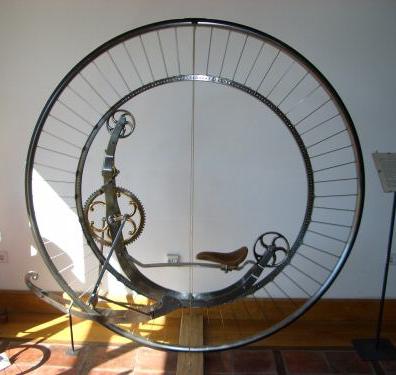
1873 Monocycle/Monowheel Replica
Posted by on August 15th,2007
The internet seems afire with talk of this marvelously crafted Monowheel replica of a 1873 design, that was up on Ebay briefly. The description sounds auto-translated, but loses none of its facination for that and you can find it in full after the cut. Basically though, a French design from 1873 recreated with as many improvements as can be thought of, and the result is quite usable. I’d advise that should you find yourself riding one of these, to avoid the peril of the gerbil, when you accelerate or decelerate too quickly and find yourself all but spinning around the centre!
Lovely though, and it looks desperately well made. I wonder what happened to the auction? (It ended with no bids for the $13,000 item.) Thanks to Mr Huang, HappyCthulhu, Apikoros (you were quite right, and thanks for the signal), and Mr Siegfried, for keeping me informed. Monowheels must be up there in the top five Steampunk methods of transport.
“Bicycle history has left us with a big range of rare and varied vehicles, especially in the last quarter of the 19th century. For many inventors, the idea of reducing the bicycle to an unique wheel could be very attractive. The first monocycles were constructed very similar to those that we see in circus attractions. The driver must be a born acrobat to be able to dominate the longitudinal and lateral balance. A more unstable vehicle is practically inconceivable. Due to this problem they invented the monocycle with interior rider.We cannot deny that then it was solved the problem of the longitudinal balance, since the gravit center of the system was kept below the center of the wheel.
After many dedication compiling information about books and documentation of epoch of the 19th century, 1got a base of knowledge to make this faithful reply of this unique monocycle for it´s funcionality and elegance. It was invented in 1873 in France.
All the pieces that compose this original way of transport have been realized by hand, recreating and improving, if possible, all details. Steel and bronze has benn confrontted, been now more attractive. The toothed wheel was dealed before in Oak´s wood as model for the bronze smelting. Later the mechanization work were carried out, polished and protection. The unions and assemblies of the system have been realized by screws(heads and square nuts) and by crushing clinches, skill very used in the 19th century. The outside consists in two hoops, 188 centimeters, lodges a bearing surface in rubber. The inside has got 238 pins, clinched on, which transfer the movement of the pine kernel. It has got a frame on which go three wheels (two guides and motive one). It carries on throught the low part by an skate, preventing then of fallen down ahead. The adjustable saddle is screwed to the mechanism of dulling by cross-bow molded and submitted to a thermal treatment in forge to obtain the suitable alasticity. The tips mounted for friction and rubbing draft in the pieces, are turned in bronze and outolubricated to guarantee smoothness and to avoid wear.
Used matertials: Steel-cool (with different alloys and hardness depending on the fatigue of work and wear to the solid alloy bronze, 43mm rubber cord torico, medium hardness, Oak´s wood, leather, brass. Metals are polished and covered with colorless protection, not using paintings, because they hide and mask the artesal finished of the pieces. The driving and the managing of the monocycle is an unique experience. The gravit, centrifuges and inertia forces are basic for it´s funcionality. Changing the weight of the body laterally the monocycle inclines, allowing us the direction. Nowadays it is an ethnographic museum.”
I’ve recreated that in full, as Ebay listings seldom last very long once closed.